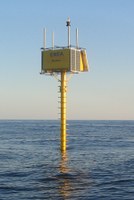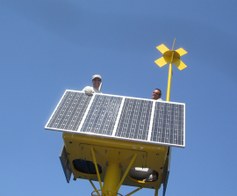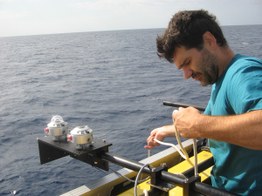Climate: ENEA inaugurates floating lab in Lampedusa for collecting data
3/12/2015
The o ceanographic buoy, positioned by ENEA researchers three miles south-west of Lampedusa, is gathering its first data. It’s an actual floating lab for climate studies, set in a sea stretch where air masses originating over Europe and Africa cross each other, particularly suitable for monitoring the state of the Mediterranean sea.
ceanographic buoy, positioned by ENEA researchers three miles south-west of Lampedusa, is gathering its first data. It’s an actual floating lab for climate studies, set in a sea stretch where air masses originating over Europe and Africa cross each other, particularly suitable for monitoring the state of the Mediterranean sea.
Measuring 40 meters, of which seven emerged, on a 74-meter-deep ocean floor, this “sentinel station”- as the ENEA researchers call it - ensures the stability necessary for accurately measuring oceanographic and atmospheric parameters and it will integrate the activities performed by the ENEA Station for Climate Observation “Roberto Sarao”, a unique infrastructure situated on the island, which has been studying the Mediterranean climate for almost two decades.
 The buoy, an elastic beacon type in technical terminology, will also be home to joint experiments with national and international research institutes, contributing to climate observation networks globally. For now the researchers have installed two radiometers and one electronic level, all connected to a data acquisition system. This first experimental phase has the objective to start gathering data and testing the functioning of the structure - including the photovoltaic supply system and the energy storage system - in rough sea and low light conditions.
The buoy, an elastic beacon type in technical terminology, will also be home to joint experiments with national and international research institutes, contributing to climate observation networks globally. For now the researchers have installed two radiometers and one electronic level, all connected to a data acquisition system. This first experimental phase has the objective to start gathering data and testing the functioning of the structure - including the photovoltaic supply system and the energy storage system - in rough sea and low light conditions.
“The sea is a significant energy resource - said Carlo Bommarito at ENEA, who supervised the design and installation of the buoy - and the heat exchange with the atmosphere is fundamental for climate determination on a regional and global scale, because it influences air temperature, weather mechanisms, the hydrologic cycle and the transfer of gas and particulate matter. The buoy will be used specifically to study the energy exchange between the sea and the atmosphere and to help validate and calibrate satellite measurements”.
 The data acquired by the ENEA radiometers positioned on the buoy will be used, together with that of the Climate Observation Station, to gain an in-depth understanding of the processes determining the Mediterranean climate. But there’s more. ENEA is about to install a weather station for measuring temperature, pressure, humidity and wind and spectrometers to determine reflectance (the proportion of light a surface can reflect) and sea colour (to determine chlorophyll concentration, suspended particulate matter and optical properties of sea water). The CNR will contribute to the equipment to be installed in the underwater part of the buoy. By next spring sensors measuring sea temperature and solar flux at different depths and determining salinity and dissolved oxygen will be installed.
The data acquired by the ENEA radiometers positioned on the buoy will be used, together with that of the Climate Observation Station, to gain an in-depth understanding of the processes determining the Mediterranean climate. But there’s more. ENEA is about to install a weather station for measuring temperature, pressure, humidity and wind and spectrometers to determine reflectance (the proportion of light a surface can reflect) and sea colour (to determine chlorophyll concentration, suspended particulate matter and optical properties of sea water). The CNR will contribute to the equipment to be installed in the underwater part of the buoy. By next spring sensors measuring sea temperature and solar flux at different depths and determining salinity and dissolved oxygen will be installed.
The buoy has been developed within the flagship project RITMARE, the main National Research Program on the sea (2012-2016), coordinated by the CNR, with an expected 250 million euro funding by the MIUR. The development of the buoy, in particular, is part of the “System for air-sea interactions studies” coordinated by ENEA, as a contribution to the Italian Network of fixed stations for sea observation and the monitoring systems of RITMARE.
For more information please contact:
Carlo Bommarito, carlo.bommarito@enea.it

 ENEA verso la COP21
ENEA verso la COP21